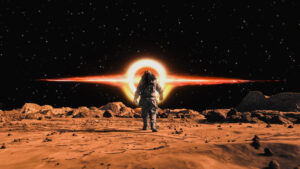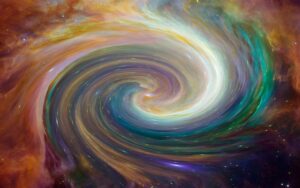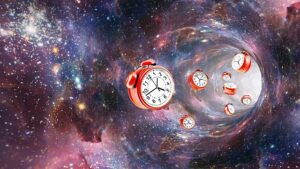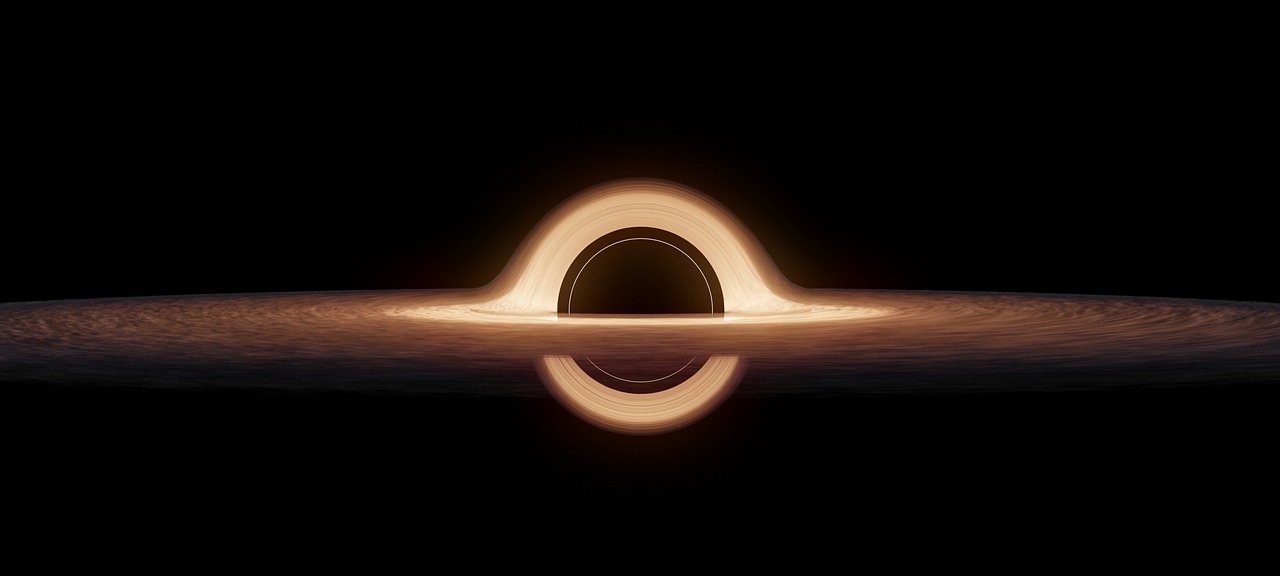The universe is incredibly vast and is estimated to be around 93 billion light-years in diameter. To put this into perspective, a light-year is the distance that light travels in one year, which is approximately 5.88 trillion miles.
In comparison, the Earth is just a tiny speck within the universe, with a diameter of about 7,917 miles. To compare the size of the Earth to the size of the universe is like comparing a grain of sand to the entire beach. The universe is so large that it is difficult for the human mind to fully grasp the concept of its size. In this universe there are billions of stars, planets, blackholes, galaxies and lot of unknown objects, Let’s take a dive into blackholes.
What is a blackhole huh…
A black hole is a region of space that has such a strong gravitational pull that nothing, including light, can escape from it. It is formed by the collapse of a massive star, and its boundary, called the event horizon, marks the point of no return. Inside the event horizon, the gravitational pull is so strong that not even light can escape, making it invisible to telescopes. However, scientists are able to detect the presence of a black hole by observing its effects on nearby matter.
How many blackholes are there and how scientist identity or find a blackhole?
The number of black holes in the universe is not known exactly, but researchers estimate that there are billions of them in our galaxy alone.
Black holes are difficult to detect directly, so scientists have to rely on indirect methods to estimate their numbers. One way to do this is by observing the effects of black holes on nearby matter. For example, when a black hole is close to a star, it can pull gas and other objects from the star and form a disk around it. This disk can emit X-rays that can be detected by telescopes. (just like webb telescopes)
Scientists also use computer simulations to model the formation and evolution of galaxies, which can give an estimate of the number of black holes in the universe.
In addition, recent observations of gravitational waves, ripples in space-time, have allowed scientists to detect the collision of two black holes, giving us a better understanding of the number of stellar black holes that exist in the universe.
As the universe is so large it’s hard to have an exact number of black holes, but the best estimates are that there are billions of them in our galaxy alone and many trillions or even more in the observable universe.
What is blackhole’s ring like thing?
Blackhole have an ring like area around them called the accretion disk, which can emit a ring-like appearance when viewed from certain angles. The accretion disk is formed by material, such as gas and dust, that is pulled into the black hole. As this material falls into the black hole, it heats up and emits light, creating the bright ring-like appearance.
The ring-like appearance is due to the strong gravity of the black hole warping the light coming from the accretion disk, this effect is called gravitational lensing. This effect causes the light to bend and create a circular image known as an “Einstein ring”.
Additionally, if the black hole is spinning, the material in the accretion disk will be moving in a circular motion, which can also create a ring-like appearance.
It’s worth noting that not all black holes have an accretion disk, for example, the black holes that are not actively accreting material. Also, black holes that are observed from a certain angle may not show a ring-like appearance.

What if human falls into blackhole? Just like Interstellar movie…
If an object, such as a spaceship or a person, were to fall into a black hole, it would be subject to the extremely strong gravitational pull of the black hole. As the object gets closer to the black hole, the gravitational pull becomes stronger and stronger, causing the object to accelerate towards the black hole.
Once the object crosses the event horizon, the point of no return, it would be unable to escape the black hole’s gravity and would be pulled towards the singularity, the point at the center of the black hole where the laws of physics as we know them break down.
The experience of falling into a black hole is not something that we can fully comprehend with our current understanding of physics. It’s expected that the immense gravitational forces would stretch and distort the object into a long, thin “spaghettification” before it reaches the singularity.
It’s also worth noting that the conditions near a black hole are extremely hostile and would likely be fatal to any living organism. The intense radiation, tidal forces and extreme temperatures would make it impossible for any living being to survive.
Keep in mind that black holes are incredibly far away and the chance of falling into one is almost zero.
Super massive blackholes…
Supermassive black holes and normal black holes are similar in many ways, but they differ in size and location.
Normal black holes are formed by the collapse of a single, massive star. They typically have masses that range from a few times to a few tens of times that of the Sun, and are found in the centers of galaxies or in binary systems. They also can have a range of sizes, from a few miles to hundreds of miles.
Supermassive black holes, on the other hand, are much larger and have masses that range from millions to billions of times that of the Sun. They are found in the centers of most, if not all, galaxies, including our own Milky Way. They are thought to have formed from the accretion of matter and the collision of smaller black holes.
The properties of supermassive black holes also differ from the normal black holes, for example, the event horizon of a supermassive black hole is much larger due to its mass, and the singularity is expected to be much denser. Supermassive blackholes also have a different impact on their surroundings, for example, they can affect the orbits of nearby stars and can also affect the evolution of galaxies by affecting the movement of gas and dust.
Supermassive blackholes are also harder to detect, as they are not surrounded by the same intense radiation and other emissions as smaller blackholes.
Overall, while normal black holes are formed by the collapse of a single massive star and can have a range of sizes, supermassive black holes are found at the center of most galaxies and are thought to have formed from the accretion of matter and the collision of smaller black holes. They are much larger than normal blackholes, have different properties and effects on their surroundings, and are harder to detect.

Smallest and largest known blackhole.
The smallest known black hole is known as a “micro black hole” which is a black hole that is smaller than the typical stellar black hole. The smallest known micro black hole is located in the galaxy RGG 118 and has a mass of around 3.3 times that of the sun. This black hole was discovered in 2020 by a team of scientists using the European Southern Observatory’s (ESO) Very Large Telescope (VLT) in Chile.
It is important to note that this is the smallest known black hole, but there could be smaller ones that haven’t been detected yet. Also, there are other theories about primordial black holes, which are even smaller and could have been formed in the early universe by density fluctuations, with masses as small as a fraction of a gram. These hypothetical black holes have not been detected yet.
The largest known black hole is known as “TON 618”, which is located in the center of a galaxy called NGC 4889. Its mass is estimated to be around 66 billion times that of the sun, making it one of the largest black holes ever discovered. It was first discovered in 2019 by a team of scientists using the Event Horizon Telescope (EHT).
It’s located around 700 million light-years away from Earth, and its event horizon is about five times larger than the orbit of Pluto. This black hole is considered to be a “supermassive” black hole, which are typically found at the centers of galaxies and can have masses ranging from millions to billions of times that of the sun.
It’s important to note that the discovery of TON 618 is still a recent discovery and it’s still being studied, there could be larger black holes that haven’t been detected yet.
Update: Recently discovered biggest blackhole is “Phoenix A”, it is 100 Million time massive than sun, Found in the center of Phoenix cluster. Phoenix A is 8.5 billion light years away from us.
Steller blackhole
A stellar black hole is a type of black hole that forms from the collapse of a single massive star at the end of its life. It is the most common type of black hole and can have masses that range from a few to tens of times that of the sun.
When a massive star runs out of fuel, it can no longer generate the energy needed to counteract the force of gravity. As a result, the star collapses under its own weight, and its core becomes so dense that not even light can escape, creating a black hole.
Stellar black holes can be found in binary systems, where they orbit another star. They can also be found in globular clusters or in the halo of a galaxy. They can be detected by observing their effects on nearby matter, such as a companion star or gas, which is pulled towards the black hole by its gravity.
Stellar black holes are different from “supermassive” black holes, which are typically found at the centers of galaxies and can have masses ranging from millions to billions of times that of the sun. Supermassive black holes are thought to have formed from the merging of many smaller black holes over time.
Will sun become blackhole?
The sun will not become a black hole because it does not have enough mass to collapse and form one.
For a black hole to form, a star must have at least three times the mass of the sun. The sun, with a mass of about 2 x 10^30 kg, is not massive enough to undergo the gravitational collapse that would be required to form a black hole.
Instead, when the sun reaches the end of its life, it will expand into a red giant and then shed its outer layers, leaving behind a white dwarf. A white dwarf is the remnant of a star that has exhausted the nuclear fuel in its core and has no further energy to generate heat and light.
It will take about 5 billion years for the sun to reach the end of its life, and it will not convert into a black hole.
Although the sun will not become a black hole, it’s worth noting that other stars in our galaxy will become black holes, and in the distant future, when our galaxy collides with the neighbouring Andromeda galaxy, there’s a good chance that the supermassive black hole at the center of our galaxy will merge with the one at the center of Andromeda, forming an even larger black hole.

What happen with time inside blackhole? Time slow down or speedup?
In the vicinity of a black hole, the strong gravitational force causes a phenomenon known as “gravitational time dilation,” which means that time appears to move more slowly the closer one gets to the black hole. This effect is caused by the warping of space-time caused by the black hole’s immense gravity.
As an observer gets closer to the black hole, the gravitational pull becomes stronger, and time appears to move more slowly. At the event horizon, the boundary beyond which nothing can escape the black hole’s gravity, time appears to stop completely. This means that an observer at the event horizon would see the clock of a distant observer as appearing to tick infinitely slowly, or not at all.
As an observer crosses the event horizon and moves towards the black hole’s singularity, the point of infinite density and zero volume at the center of the black hole, where the laws of physics as we know them break down. Time becomes so distorted that it is essentially meaningless.
It’s worth noting that these effects are only apparent to an observer outside the black hole and for an object that falls into a black hole, time would seem to pass normally. However, the closer an object gets to the singularity, the stronger the gravitational pull, and the more distorted time becomes.
time is distorted near a black hole, with the effect becoming more pronounced the closer one gets to the event horizon and the singularity. At the event horizon, time appears to stop completely and beyond that, time will be meaningless.
Legends who gave incredible information about blackhole theory..
Stephen Hawking and Jacob Bekenstein are considered to be two of the most prominent contributors to the study of black hole information. Stephen Hawking proposed the idea that black holes emit radiation, now known as Hawking radiation, which led to the concept of black hole entropy. Jacob Bekenstein proposed that black holes have entropy and a temperature, which is related to the area of the black hole’s event horizon. Both of these ideas have had a significant impact on the study of black hole physics and the understanding of the nature of information in black holes.
Movies related to blackhole concept…
There have been several movies that feature black holes or incorporate black hole concepts as a central theme. Some examples include:
- “Interstellar” (2014) – directed by Christopher Nolan, starring Matthew McConaughey and Anne Hathaway, the movie explores the concept of using a wormhole to travel through time and space, and how a black hole is used as a major plot point in the story.
- “Event Horizon” (1997) – directed by Paul W. S. Anderson, starring Laurence Fishburne and Sam Neill, the movie tells the story of a rescue team that is sent to investigate a missing spaceship that has reappeared, and how the ship encountered a black hole and the impact that has on the crew.
- “The Black Hole” (1979) – directed by Gary Nelson, starring Maximilian Schell, Anthony Perkins and Robert Forster, the movie is about a group of scientists on a spaceship who discover a mysterious black hole and the dark secrets it holds.
- “Gravity” (2013) – directed by Alfonso Cuarón, starring Sandra Bullock and George Clooney, the movie tells the story of two astronauts who are stranded in space after the destruction of their shuttle, and how they try to survive and return to Earth while dealing with the effects of a nearby black hole.
- “The Theory of Everything” (2014) – directed by James Marsh, starring Eddie Redmayne and Felicity Jones, the movie is a biographical film based on Stephen Hawking’s early life, and how he developed his theories on black holes and cosmology.
Final words:
black holes are a fascinating and mysterious concept that can be both daunting and awe-inspiring due to their immense power and size, and the fact that they are a subject of ongoing research, makes them even more intriguing.

Good insights